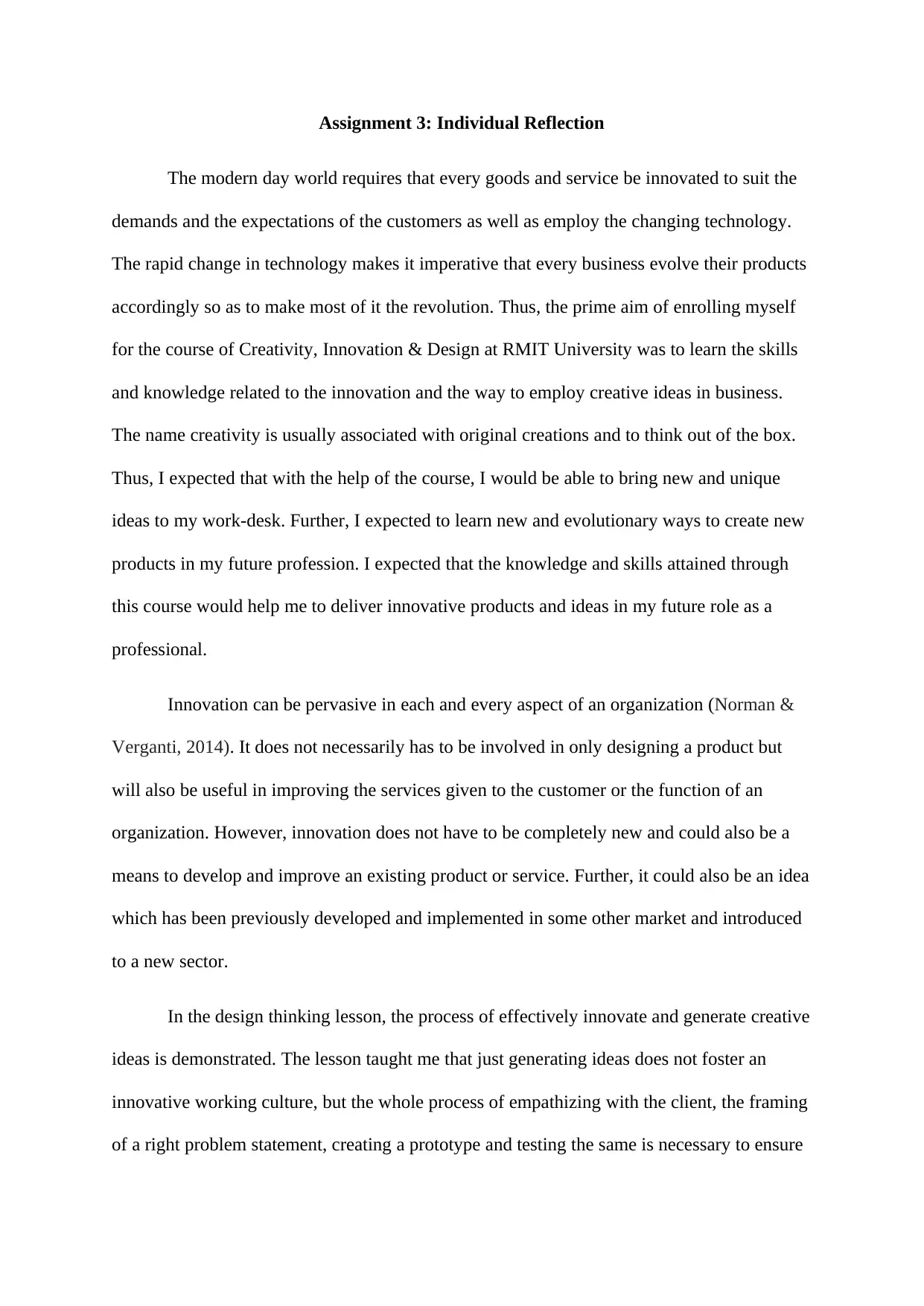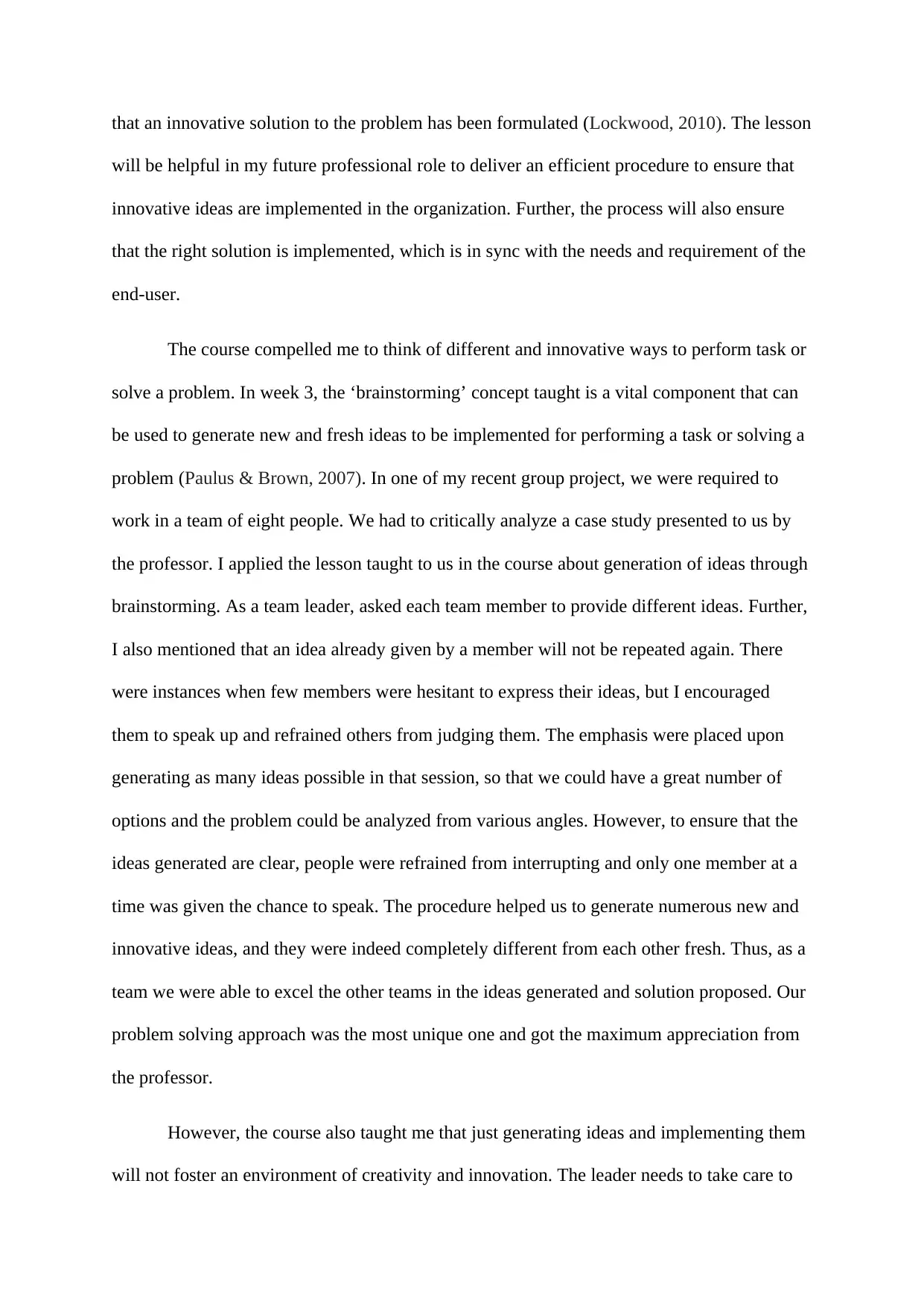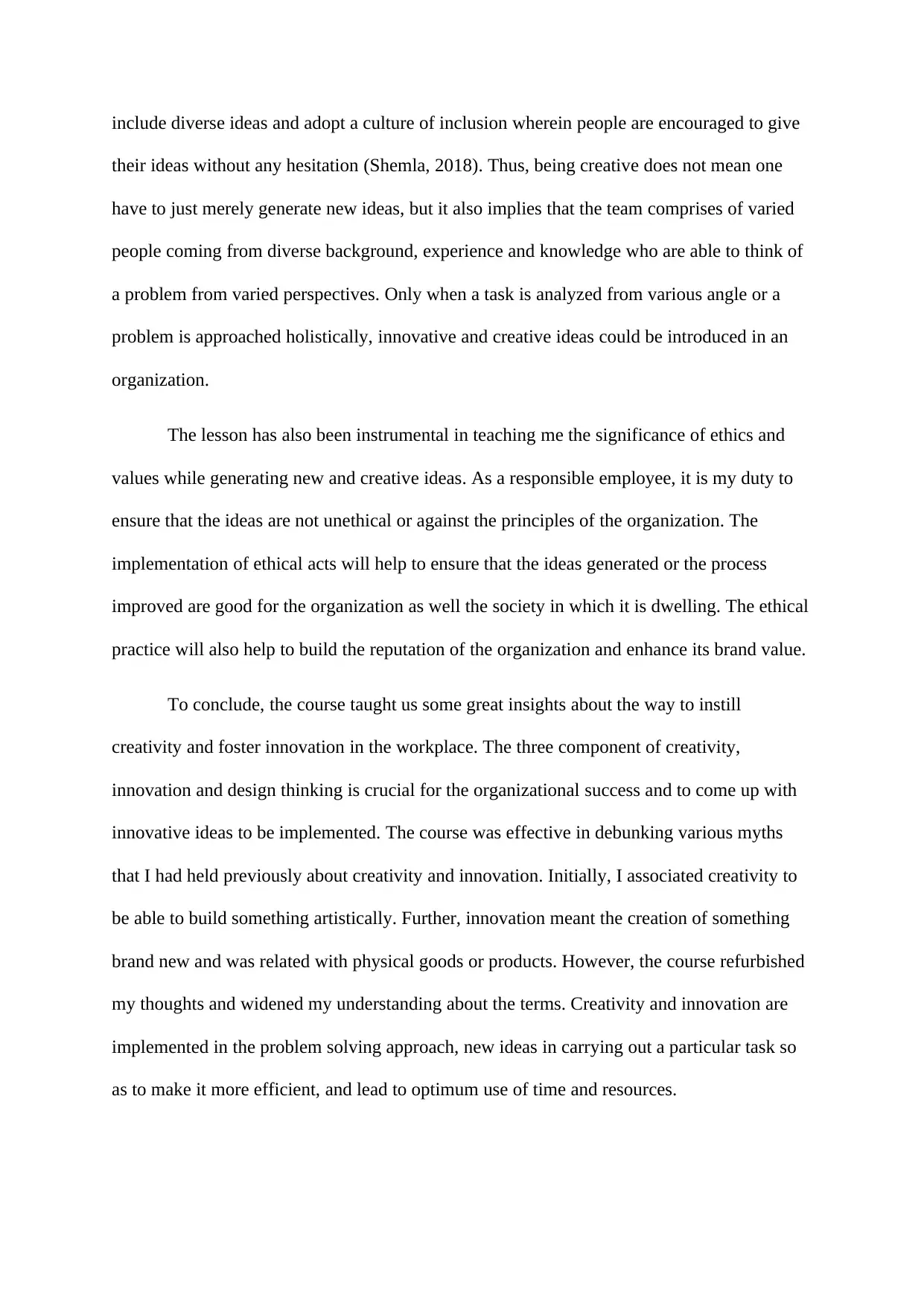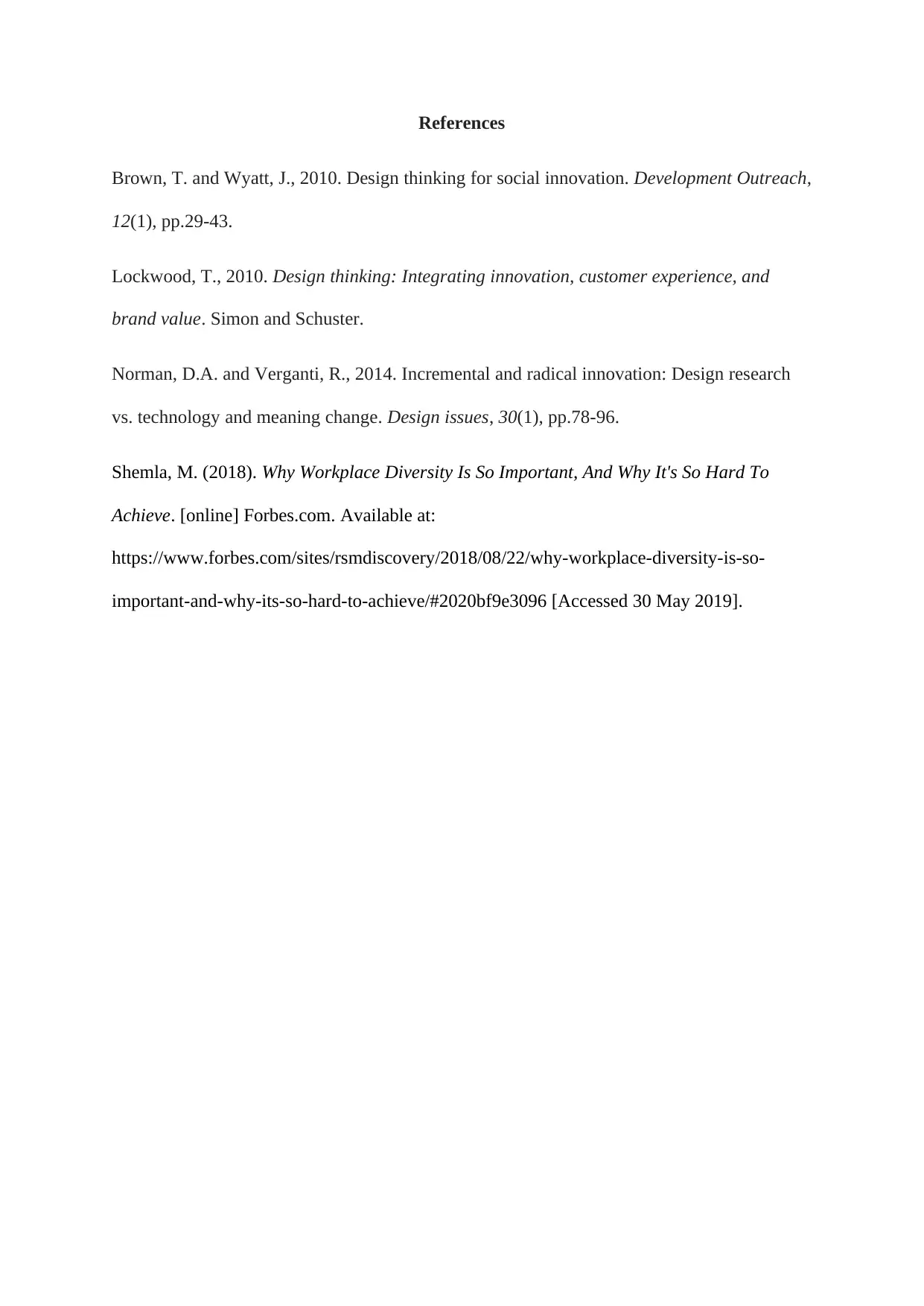RMIT Individual Reflection: Creativity, Innovation, and Design Course
VerifiedAdded on 2023/03/30
|4
|1092
|192
Essay
AI Summary
This essay presents a student's individual reflection on the Creativity, Innovation & Design course at RMIT University. It delves into their initial expectations, the impact of the course on those views, and the knowledge and skills acquired. The reflection highlights the importance of design thinking, brainstorming, and ethical considerations in fostering creativity and innovation. The student provides a real-world example of applying these concepts in a group project, demonstrating improved problem-solving abilities. The essay concludes by emphasizing the crucial role of creativity, innovation, and design thinking in organizational success and personal development, debunking previous misconceptions about these concepts.

Assignment 3: Individual Reflection
The modern day world requires that every goods and service be innovated to suit the
demands and the expectations of the customers as well as employ the changing technology.
The rapid change in technology makes it imperative that every business evolve their products
accordingly so as to make most of it the revolution. Thus, the prime aim of enrolling myself
for the course of Creativity, Innovation & Design at RMIT University was to learn the skills
and knowledge related to the innovation and the way to employ creative ideas in business.
The name creativity is usually associated with original creations and to think out of the box.
Thus, I expected that with the help of the course, I would be able to bring new and unique
ideas to my work-desk. Further, I expected to learn new and evolutionary ways to create new
products in my future profession. I expected that the knowledge and skills attained through
this course would help me to deliver innovative products and ideas in my future role as a
professional.
Innovation can be pervasive in each and every aspect of an organization (Norman &
Verganti, 2014). It does not necessarily has to be involved in only designing a product but
will also be useful in improving the services given to the customer or the function of an
organization. However, innovation does not have to be completely new and could also be a
means to develop and improve an existing product or service. Further, it could also be an idea
which has been previously developed and implemented in some other market and introduced
to a new sector.
In the design thinking lesson, the process of effectively innovate and generate creative
ideas is demonstrated. The lesson taught me that just generating ideas does not foster an
innovative working culture, but the whole process of empathizing with the client, the framing
of a right problem statement, creating a prototype and testing the same is necessary to ensure
The modern day world requires that every goods and service be innovated to suit the
demands and the expectations of the customers as well as employ the changing technology.
The rapid change in technology makes it imperative that every business evolve their products
accordingly so as to make most of it the revolution. Thus, the prime aim of enrolling myself
for the course of Creativity, Innovation & Design at RMIT University was to learn the skills
and knowledge related to the innovation and the way to employ creative ideas in business.
The name creativity is usually associated with original creations and to think out of the box.
Thus, I expected that with the help of the course, I would be able to bring new and unique
ideas to my work-desk. Further, I expected to learn new and evolutionary ways to create new
products in my future profession. I expected that the knowledge and skills attained through
this course would help me to deliver innovative products and ideas in my future role as a
professional.
Innovation can be pervasive in each and every aspect of an organization (Norman &
Verganti, 2014). It does not necessarily has to be involved in only designing a product but
will also be useful in improving the services given to the customer or the function of an
organization. However, innovation does not have to be completely new and could also be a
means to develop and improve an existing product or service. Further, it could also be an idea
which has been previously developed and implemented in some other market and introduced
to a new sector.
In the design thinking lesson, the process of effectively innovate and generate creative
ideas is demonstrated. The lesson taught me that just generating ideas does not foster an
innovative working culture, but the whole process of empathizing with the client, the framing
of a right problem statement, creating a prototype and testing the same is necessary to ensure
Paraphrase This Document
Need a fresh take? Get an instant paraphrase of this document with our AI Paraphraser

that an innovative solution to the problem has been formulated (Lockwood, 2010). The lesson
will be helpful in my future professional role to deliver an efficient procedure to ensure that
innovative ideas are implemented in the organization. Further, the process will also ensure
that the right solution is implemented, which is in sync with the needs and requirement of the
end-user.
The course compelled me to think of different and innovative ways to perform task or
solve a problem. In week 3, the ‘brainstorming’ concept taught is a vital component that can
be used to generate new and fresh ideas to be implemented for performing a task or solving a
problem (Paulus & Brown, 2007). In one of my recent group project, we were required to
work in a team of eight people. We had to critically analyze a case study presented to us by
the professor. I applied the lesson taught to us in the course about generation of ideas through
brainstorming. As a team leader, asked each team member to provide different ideas. Further,
I also mentioned that an idea already given by a member will not be repeated again. There
were instances when few members were hesitant to express their ideas, but I encouraged
them to speak up and refrained others from judging them. The emphasis were placed upon
generating as many ideas possible in that session, so that we could have a great number of
options and the problem could be analyzed from various angles. However, to ensure that the
ideas generated are clear, people were refrained from interrupting and only one member at a
time was given the chance to speak. The procedure helped us to generate numerous new and
innovative ideas, and they were indeed completely different from each other fresh. Thus, as a
team we were able to excel the other teams in the ideas generated and solution proposed. Our
problem solving approach was the most unique one and got the maximum appreciation from
the professor.
However, the course also taught me that just generating ideas and implementing them
will not foster an environment of creativity and innovation. The leader needs to take care to
will be helpful in my future professional role to deliver an efficient procedure to ensure that
innovative ideas are implemented in the organization. Further, the process will also ensure
that the right solution is implemented, which is in sync with the needs and requirement of the
end-user.
The course compelled me to think of different and innovative ways to perform task or
solve a problem. In week 3, the ‘brainstorming’ concept taught is a vital component that can
be used to generate new and fresh ideas to be implemented for performing a task or solving a
problem (Paulus & Brown, 2007). In one of my recent group project, we were required to
work in a team of eight people. We had to critically analyze a case study presented to us by
the professor. I applied the lesson taught to us in the course about generation of ideas through
brainstorming. As a team leader, asked each team member to provide different ideas. Further,
I also mentioned that an idea already given by a member will not be repeated again. There
were instances when few members were hesitant to express their ideas, but I encouraged
them to speak up and refrained others from judging them. The emphasis were placed upon
generating as many ideas possible in that session, so that we could have a great number of
options and the problem could be analyzed from various angles. However, to ensure that the
ideas generated are clear, people were refrained from interrupting and only one member at a
time was given the chance to speak. The procedure helped us to generate numerous new and
innovative ideas, and they were indeed completely different from each other fresh. Thus, as a
team we were able to excel the other teams in the ideas generated and solution proposed. Our
problem solving approach was the most unique one and got the maximum appreciation from
the professor.
However, the course also taught me that just generating ideas and implementing them
will not foster an environment of creativity and innovation. The leader needs to take care to

include diverse ideas and adopt a culture of inclusion wherein people are encouraged to give
their ideas without any hesitation (Shemla, 2018). Thus, being creative does not mean one
have to just merely generate new ideas, but it also implies that the team comprises of varied
people coming from diverse background, experience and knowledge who are able to think of
a problem from varied perspectives. Only when a task is analyzed from various angle or a
problem is approached holistically, innovative and creative ideas could be introduced in an
organization.
The lesson has also been instrumental in teaching me the significance of ethics and
values while generating new and creative ideas. As a responsible employee, it is my duty to
ensure that the ideas are not unethical or against the principles of the organization. The
implementation of ethical acts will help to ensure that the ideas generated or the process
improved are good for the organization as well the society in which it is dwelling. The ethical
practice will also help to build the reputation of the organization and enhance its brand value.
To conclude, the course taught us some great insights about the way to instill
creativity and foster innovation in the workplace. The three component of creativity,
innovation and design thinking is crucial for the organizational success and to come up with
innovative ideas to be implemented. The course was effective in debunking various myths
that I had held previously about creativity and innovation. Initially, I associated creativity to
be able to build something artistically. Further, innovation meant the creation of something
brand new and was related with physical goods or products. However, the course refurbished
my thoughts and widened my understanding about the terms. Creativity and innovation are
implemented in the problem solving approach, new ideas in carrying out a particular task so
as to make it more efficient, and lead to optimum use of time and resources.
their ideas without any hesitation (Shemla, 2018). Thus, being creative does not mean one
have to just merely generate new ideas, but it also implies that the team comprises of varied
people coming from diverse background, experience and knowledge who are able to think of
a problem from varied perspectives. Only when a task is analyzed from various angle or a
problem is approached holistically, innovative and creative ideas could be introduced in an
organization.
The lesson has also been instrumental in teaching me the significance of ethics and
values while generating new and creative ideas. As a responsible employee, it is my duty to
ensure that the ideas are not unethical or against the principles of the organization. The
implementation of ethical acts will help to ensure that the ideas generated or the process
improved are good for the organization as well the society in which it is dwelling. The ethical
practice will also help to build the reputation of the organization and enhance its brand value.
To conclude, the course taught us some great insights about the way to instill
creativity and foster innovation in the workplace. The three component of creativity,
innovation and design thinking is crucial for the organizational success and to come up with
innovative ideas to be implemented. The course was effective in debunking various myths
that I had held previously about creativity and innovation. Initially, I associated creativity to
be able to build something artistically. Further, innovation meant the creation of something
brand new and was related with physical goods or products. However, the course refurbished
my thoughts and widened my understanding about the terms. Creativity and innovation are
implemented in the problem solving approach, new ideas in carrying out a particular task so
as to make it more efficient, and lead to optimum use of time and resources.
⊘ This is a preview!⊘
Do you want full access?
Subscribe today to unlock all pages.

Trusted by 1+ million students worldwide

References
Brown, T. and Wyatt, J., 2010. Design thinking for social innovation. Development Outreach,
12(1), pp.29-43.
Lockwood, T., 2010. Design thinking: Integrating innovation, customer experience, and
brand value. Simon and Schuster.
Norman, D.A. and Verganti, R., 2014. Incremental and radical innovation: Design research
vs. technology and meaning change. Design issues, 30(1), pp.78-96.
Shemla, M. (2018). Why Workplace Diversity Is So Important, And Why It's So Hard To
Achieve. [online] Forbes.com. Available at:
https://www.forbes.com/sites/rsmdiscovery/2018/08/22/why-workplace-diversity-is-so-
important-and-why-its-so-hard-to-achieve/#2020bf9e3096 [Accessed 30 May 2019].
Brown, T. and Wyatt, J., 2010. Design thinking for social innovation. Development Outreach,
12(1), pp.29-43.
Lockwood, T., 2010. Design thinking: Integrating innovation, customer experience, and
brand value. Simon and Schuster.
Norman, D.A. and Verganti, R., 2014. Incremental and radical innovation: Design research
vs. technology and meaning change. Design issues, 30(1), pp.78-96.
Shemla, M. (2018). Why Workplace Diversity Is So Important, And Why It's So Hard To
Achieve. [online] Forbes.com. Available at:
https://www.forbes.com/sites/rsmdiscovery/2018/08/22/why-workplace-diversity-is-so-
important-and-why-its-so-hard-to-achieve/#2020bf9e3096 [Accessed 30 May 2019].
1 out of 4
Related Documents
Your All-in-One AI-Powered Toolkit for Academic Success.
+13062052269
info@desklib.com
Available 24*7 on WhatsApp / Email
![[object Object]](/_next/static/media/star-bottom.7253800d.svg)
Unlock your academic potential
Copyright © 2020–2025 A2Z Services. All Rights Reserved. Developed and managed by ZUCOL.





